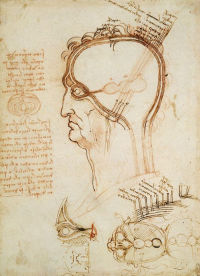Light and Vision Click on the thumbnails to explore the trail
Read more about this trail (expand)
According to Leonardo, the most important of the five senses was sight, the eye being the “window of the soul”. Leonardo thought a great deal about how the eye functioned and how we experience the world in terms of light and shade. His studies of the effects of light on form provided the basis for a revolution in the way that light, colour and space were described in painting.

- Enlarge
- Zoom & explore
- The Royal Collection © 2005, Her Majesty Queen Elizabeth II
Diagrammatic drawing illustrating how sight works c1489-92
Leonardo believed that sight was the most important of all the senses. His understanding of how the brain functions confirms this view.
In this profile drawing of a male head, Leonardo adheres to the conventional view that the brain possessed three inter-connected ventricles, each which facilitated a particular stage in perception.
The first, called the imprensiva, receives information gained from the senses.
This travels to the second chamber called the sensus communis, where fantasia or imagination resides along with intelletto or intellectual reason. Leonardo believed that this was the site of the human soul, as illustrated in his Study of a human skull. The sensus communis is attached to a third chamber called the memoria, where information could be stored.
Priority is given to information gained through sensory perception in Leonardo’s theory. The imagination cannot visualise such beauty as is seen by the eye. This is because the eye receives the appearance of images or objects and transmits them through the sense organs to the understanding where they are judged. Forms created in the imagination are therefore inferior; ultimately they fade and die in the memoria.
In Leonardo's words
The eye, which is the window of the soul, is the chief organ whereby the understanding can have the most complete and magnificent view of the infinite works of nature; and the ear comes second, which acquires dignity by hearing things the eye has seen.
This sheet of sections of the human head continues the investigations of the Skull Sectioned drawing of 1489.
The main focus of the sheet is the layered structure of the scalp, skull and brain. In the main study, a male head seen in profile section, Leonardo illustrates the conventional notion of three “ventricles” contained within the brain connected directly to the eye which contain a spherical “lens”.
The conception illustrated here that the eye is a geometrically constructed unit that communicates directly with the imprensiva (receptor of impressions), the sensus communis (confluence of the senses), intellect and memory is dependent on the traditional idea of how sight and the brain functioned. The system as Leonardo illustrates it emphasises the priority of sensory perception and the supremacy of sight over the other senses.
The note in red chalk on the left compares the layers of the skull and the brain with the skins of an onion, which is illustrated in section. Below the main drawing is a section of the head showing the layers of the scalp, skull and brain, a section of the eye, and the head as seen from above.
The layers of the skull are recorded as “hair, scalp, lacterous flesh, pericranium, cranium, pia mater, dura mater, brain”. The dura mater and the pia mater have been given in their correct order in the upper diagram, but here they are reversed.
- Medium Pen and ink and red chalk on white paper
- Size 20.6 x 14.8 cm
- Location The Royal Collection











